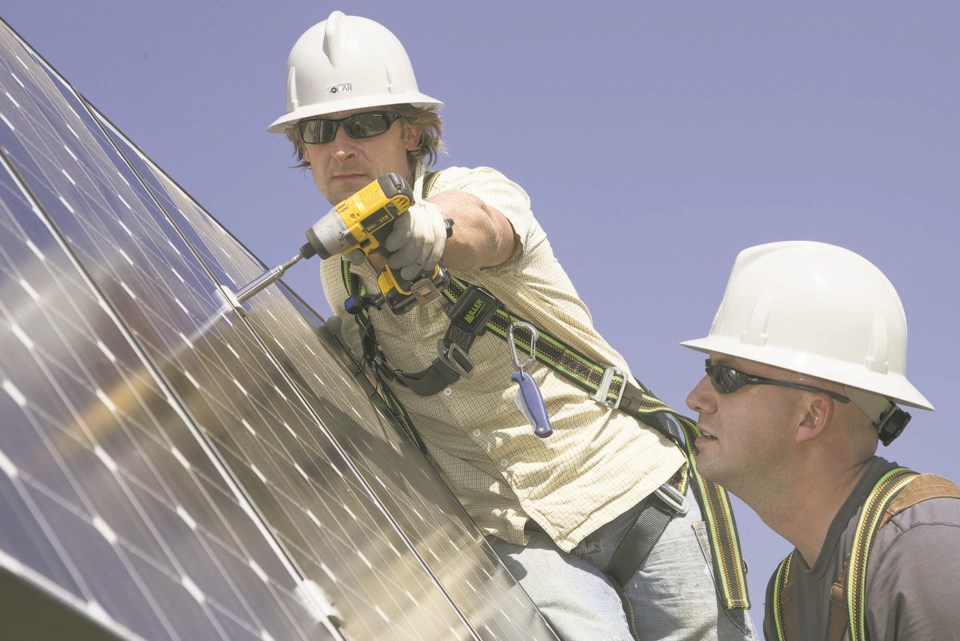St. Albert residents will have a chance to add insulation and solar to their homes for no money down next week as the city’s new CEIP program opens for applications.
The City of St. Albert announced via Twitter on Nov. 10 that the Clean Energy Improvement Program (CEIP) would open to pre-qualification applications on Nov. 22.
Approved in May 2021, CEIP lets St. Albert residents have certified contractors add energy efficiency and renewable power upgrades to their homes for no money down, with the cost of those upgrades repaid over decades through an addition to their property taxes. The city got $5 million in federal support for this program last October.
CEIP aims to help residents overcome the often high up-front costs of upgrades such as solar panels by providing financing, said Meghan Myers, acting environmental manager for the City of St. Albert. The program should create local jobs, make homes more comfortable, and help residents cut energy costs and greenhouse gas emissions.
“We anticipate it will be a popular program,” Myers said.
How CEIP works
CEIP lets applicants fund up to $50,000 worth of energy-saving or renewable power upgrades to their homes over time through their property taxes instead of all at once up-front.
To get that cash, applicants must meet a long list of terms and conditions set out on the program’s website.
Applicants must legally own the upgraded home, must not be bankrupt or have any legal issues with the City of St. Albert, and must have paid their property taxes on time in each of the last five years, the website showed. The home itself must be insured, in St. Albert, lawfully occupied, low-rise residential (i.e. a detached, semi-detached, row, or townhouse home), and up to three storeys tall and 600 square meters big. Any upgrades financed through CEIP must cost at least $3,000, add energy efficiency or renewable power to the home, be installed by a qualified contractor, and be permanently affixed to the property.
Applicants start the CEIP process by filing for pre-qualification, which requires, at minimum, proof of home insurance, Myers explained.
Next, applicants have to have an EnerGuide audit done on their home, with any audit done after April 1, 2020, considered valid, the program website showed. Once they get quotes from contractors and approval from Alberta Municipalities, applicants have six months to complete their upgrades, after which the costs are added to their property taxes.
Myers said each upgrade will be listed as a separate Clean Energy Improvement Tax on a home’s tax bill.
Applicants pay those costs over up to 20 years at three per cent interest or less. If they sell their home before all costs are paid, they pass the remaining costs onto the new owner.
The program covers a long list of upgrades related to heat, lighting, insulation, and renewable power. Applicants can get $650 to help pay for their energy audit and $750 to pay for upgrades, both of which would be applied directly to their property taxes (i.e. you won’t get a cheque).
Myers said applicants can combine CEIP with cash from the federal Greener Homes program and the upcoming St. Albert Home Energy Efficiency Grant.
Ready to retrofit
St. Albert homeowner and PACE Alberta president Leigh Bond was happy to hear that CEIP had launched, saying that he and several other residents he knew already had their applications ready to go.
“My intent is to make my house net-zero,” he said, which would involve adding solar panels to his roof and replacing his furnaces with geothermal heat.
Bond said these upgrades would cost him about $78,000, which he hoped to cover entirely through CEIP and the Greener Homes program. The upgrades would eliminate his need for natural gas and substantially reduce his monthly bills.
“By getting rid of natural gas completely, I am on the way to being carbon-neutral,” Bond said, allowing him to help keep global heating in check.
Myers said CEIP funding will roll out over four years, with about $1 million available in this first year. Anyone who misses out on this round of funding will likely go on a wait-list for future rounds.
Bond said anyone planning to apply for CEIP should schedule an energy audit right away — the wait-list in the Edmonton region was about three months long at this point. He expected this year’s CEIP funding to get snatched up very quickly.
Once you have that audit, sequence your upgrades to get to net-zero with as little waste as possible, said Peter Amerongen, a net-zero home designer and renovator with ReNü Engineering. Don’t re-insulate your attic before you air-seal it, for example — one of his recent clients did, and he had to suck out and re-do the attic insulation as a result.
Amerongen said net-zero home renovations are essential if humanity is to fend off catastrophic climate change. They also make homes cheaper to run.
“It’s going to be a lot of up-front (cost), but you’re going to be laughing while other people are paying carbon tax.”
Visit ceip.abmunis.ca/residential/locations/st-albert for details on CEIP in St. Albert.



